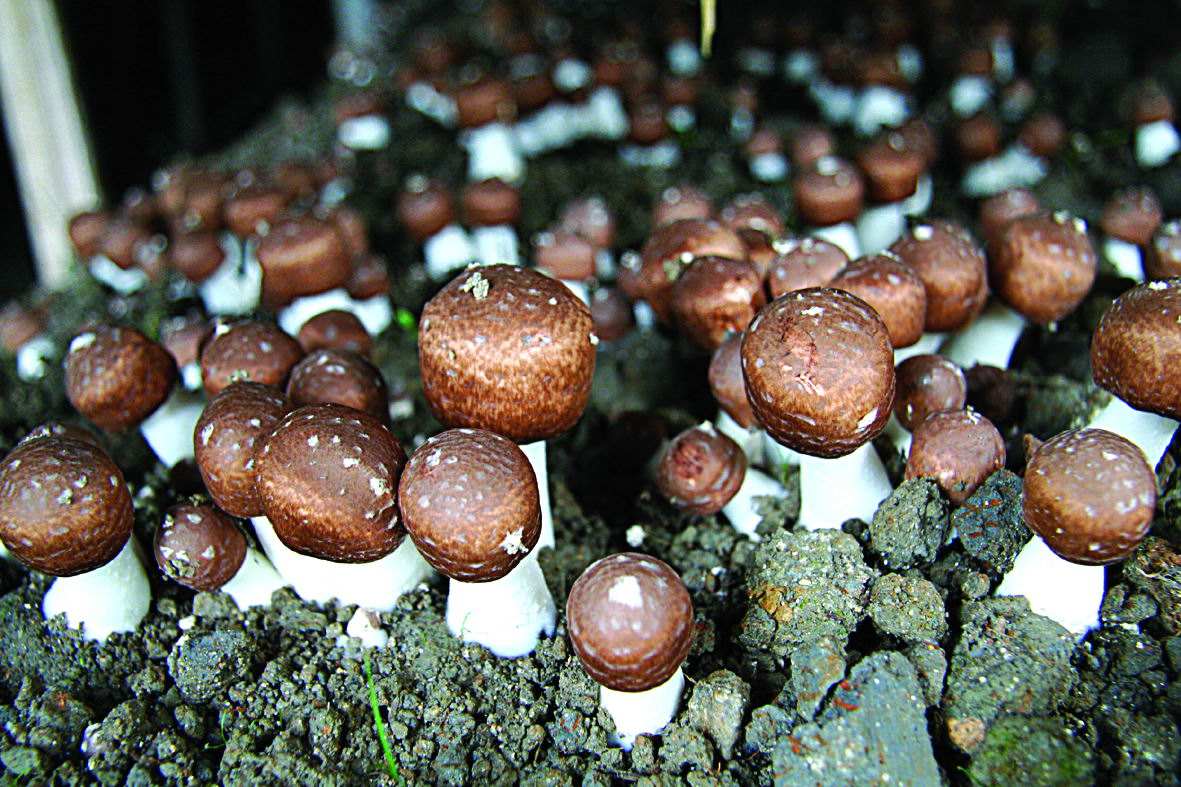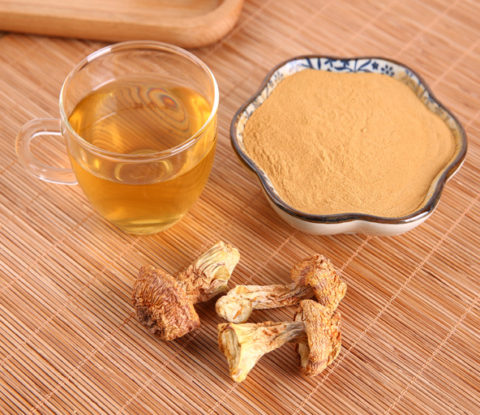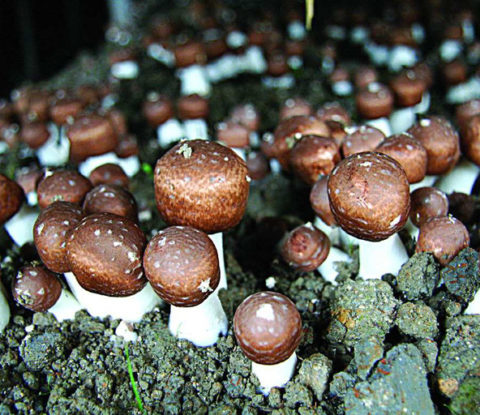
Agaricus Blazei Extract Powder Polysaccharides 10%,20%,30%,50% UV
Agaricus blazei havs high anti-cancer activity, enhance cellular immune function, lower blood sugar, regulate blood pressure, resist arteriosclerosis, improve bone hyperplasia, and have calming effects.
Agaricus Blazei Extract Powder Polysaccharides 10%,20%,30%,50% UV
【Latin Name】: Agaricus blazei muril
【Part Used】: Fruitingbody&mycelium
【Active ingredients】: polysaccharides
【Specification】: Polysaccharides 10%~50% UV,10:1,20:1TLC
【Appearance】: Brown fine powder
【Particle size】: 100% pass 80 mesh
【Main Function】: Stimulate Immune System
 Agaricus Blazei Extract Production Flowchart
Agaricus Blazei Extract Production Flowchart
Agaricus Blazei raw materials – natural air drying–Coarse powder(40 mesh) -Low temperature water extraction – 1st Reflux Extraction(10 times water,2 Hrs) – 2nd Reflux Extraction8 times water,1.5 Hrs) – 3rd Reflux Extraction(6 times water,1 Hrs) – Extraction Solution-combine&Filtrate-Concentrate-Extractum-spray drying – screening – packaging – detection of physical and chemical indicators – warehousing
Specification of Agaricus Blazei Extract
| Item | Standard | Test method |
| Appearance | Brownish Yellow fine powder | Visual & Organoleptic |
| Specification | Polysaccharides 30% | UV |
| Particle size | 80 mesh | Pass 80 mesh size screen |
| Ash | <13% | 2g/525℃/3hrs |
| Moisture | <7% | 5g/100℃/2.5hrs |
| Heavy metals | As <1.0ppm Pb<2.0PPM Hg<0.2ppm Cd<1.0ppm | Atomic Absorption |
| Microbiological Control | Total Plate Count<10,000cfu/g, Yeast & Mold<100cfu/g, E.Coli<10cfu/g. |
AOAC |
| Packing | 1kg/bag, 5kg/bag, or 25kg/fiber drum (D* H, 40*50cm),
It can also be packaged according to the requirements of customers, and all the packaging materials meet the standards of Chinese Pharmacopoeia 2010. |
|
Brief Introudction of Agaricus Blazei Extract
Agaricus blazei Murill was discovered in 1960 by Takatoshi Furumoto, near a small Brazilian village Piedade located in the highland areas of the Atlantic forest near Sao Paolo (Brazil). According to legend, the elderly people in this region were less likely to suffer from serious diseases than those in the neighboring communities.
Because of its alleged health effects, it was brought to Japan and subjected to biomedical research, which confirmed the mushroom’s richness in immunomodulating substances such as β-glucans. Since that time it has been widely cultivated in Japan for medicinal purposes. Based on DNA sequence analysis (rDNA ITS region) and on mapping studies and genetic analysis of hybrid progeny, there is a strong case for co-specificity of the Brazilian mushrooms with Agaricus subrufescens. Based on a study of the type and other data, the recent lecto typification of A. subrufescens is widely accepted. Since the time the mushroom became subjected to intensive scientific research some 35 years ago, it has become widely known. Scientific studies have focused mainly on the effect of ABM as an immunomodulating agent, and its therapeutic effect in connection with infections and cancer.
The history of Agaricus blazei Murill is tightly linked to the mountain village Piedade, located within the Atlantic rain forest, about one hundred kilometers west of Sao Paulo, Brazil. It is well known to the people of this region as a traditional panacea bringing longevity and health. The mushroom itself was considered as something more than just food, which is reflected in some local names, including: Cogumelo da Vida and Cogumelo de Deus – Portuguese for mushroom of life and mushroom of God. Meanwhile, the first historical description about the use of this mushroom for medicinal purposes comes from Byzantine medical treatises, showing its long tradition. Since Takatoshi Furumoto became interested in the mushroom in the 1960’s, Agaricus Blazei has become a serious topic for researchers in different fields, in which it has been investigated for its health benefits.
The mushroom got to be more and more popular. At the beginning of the 1970’s, researchers began studying the surprisingly unusual low rate of geriatric illness among inhabitants of Piedade. This was followed by attempts to cultivate the mushroom world-wide. The mushroom was found to be rich in immune-modulating substances such as β-glucans and proteoglycans, and presented anti-infection and anti-tumor effects in animal studies. Currently, Agaricus blazei Murill remains under intense investigation, and the results are published in major scientific journals. The mushroom is one of the most promising anti-cancer remedies and stimulants of the efficient and broad-spectered innate immune system.
Chemical Composition
The fruiting bodies of A. subrufescens contain 89–91% water, which is in general less than that of A. bisporus. Almost 48% of total dry matter consists of crude protein and 18% of carbohydrates, but the lipid content is only 0.5% ( Györfi et al., 2010). The fruiting bodies of A. subrufescens contain high levels of valuable minerals, e.g. potassium, phosphorus, calcium, magnesium and zinc. Nevertheless, a minute amount of cadmium was also detectable ( Györfi et al., 2010).
Bioactive compounds of mushrooms can be isolated from their fruiting bodies, or culture extraction from pure culture of mycelia (Chang and Miles, 2004). A. subrufescens has been reported to produce various bioactive compounds that have potential to treat many diseases ( Firenzuoli et al., 2008). This mushroom has been used as a medicinal food for the prevention of cance-r, diabetes, hyperlipidemia, arteriosclerosis, and chronic hepatitis, and is known to stimulate the immune system ( Takaku et al., 2001).
Several categories of molecules are involved in beneficial effects of A. subrufescens and most of them are common to the entire fungal kingdom ( Levitz, 2010). Some compounds (such as ergosterol and β-glucans) are considered as biochemical markers for the kingdom and are ubiquitous. β-Glucans are cell wall constituents that can be found in many fungi ( Levitz, 2010).
The bioactive compounds isolated from A. subrufescens are mainly polysaccharides such as riboglucans ( Cho et al., 1999, Gonzaga et al., 2005, Fujimiya et al., 1998 and Mizuno et al., 1990) and glucomannans ( Hikichi et al., 1999). Chemical analysis of polysaccharides in A. subrufescens has been measured using High Performance Liquid Chromatography (HPLC) ( Volman et al., 2010). A. subrufescens polysaccharide consists of 57.7% glucose, 27.7% galactose, 7.3% mannose/xylose, and 4% fucose ( Volman et al., 2010). Structural analysis of β-glucans with 1–4 and 1–6 linkages showed they were presented in a ratio of about 1:1. A small proportion of 1–3 linkages was also detected ( Volman et al., 2010). More recently, a new configuration of polysaccharide purified from A. subrufescens has been proposed ( Liu et al., 2011). The purified polysaccharide had a (1–6)-linked α-d-glucopyranosyl backbone and one terminal (1-)-α-d-glucopyranosyl branch along the main chain in a ratio of 1:1:1 ( Liu et al., 2011 and Liu and Sun, 2011). The extract probably existed in a triple-strand helical conformation in water ( Liu et al., 2011). Alkaline extraction and methylation analysis of purified polysaccharide from A. subrufescens showed six types of residues ( Liu and Sun, 2011). The extract had a backbone consisting of (1–6) linked-β-d galactopyranosyl, (1–6) linked-β-d glucopyranosyl and (1–3,6)-linked β-d glucopyranosyl residues and branched with three terminal (1-)-β-l-fucopyranosyl, (1-)-β-l-arabinofuranose and (1-)-β-d glucopyranosyl unit at the O-3position of (1–3,6)-linked-α-d-glucopyranosyl along the main chain in the ratio of 20:10:10:6:2:2 ( Liu and Sun, 2011).
Anti-tumor activity has been found in lipid fractions of A. subrufescens ( Takaku et al., 2001). The bioactive substance with the anti-tumor effect was purified and then identified as ergosterol ( Takaku et al., 2001). Ergosterol is functionally an analog of mammalian cholesterol. It is a component of the fungal cell membrane and has been described as the beneficial component in some medicinal mushrooms such as Lentinus edodes (Berk) Pegler ( Jasinghe and Perera, 2005), A. bisporus (J.E. Lange) Imbach ( Lindequist et al., 2005 and Volman et al., 2010), Grifola frondosa (Dicks.) Gray ( Lindequist et al., 2005) and Ganoderma lucidum (Curtis) P. Karst ( Lindequist et al., 2005).
Health Benefits of Agaricus Blazei Murill
1).Anti-cancer and anti-tumor effects
Cancer is a disease which is characterized by uncontrolled cell growth (a division beyond normal limits), and is the leading cause of death in Western countries. Cancer may affect people at all ages and genders. The risk for most types of cancer increases with age, and is primarily impacted by environmental factors with a 90-95% of cases influenced by lifestyle and environmental factors and 5-10% due to genetics.
It has been shown that a significant number of cancer patients have been taking complementary medical therapies such as medicinal mushrooms, while receiving their conventional anti-cancer treatments. Mushroom extracts have been proposed to have anti-cancer properties and may act through two separate mechanisms: i) direct cytotoxic effect and ii) indirectly through immunomodulatory action. The orally administered β-glucans were taken up and processed by macrophages via surface receptors such as Dectin-1 with or without TLR-2/6, and complement receptor (CR)-3, eliciting an immune response. One of the actions is the phagocytosis of antibody-tagged tumor cells.Another direct consequence of AbM treatment in cancer patients, and possibly brought about by the mushroom’s beta-glucans, is activation of the patients’ NK cells. Studies found that a group of active ingredients such as beta-glucans, proteoglycans and ergosterol were responsible for the induced tumor regression in mice. Additionally, mice which were supplemented daily with beta-glucan isolated from AbM, exhibited a decreased level of spontaneous metastasi. In another set of experiments, fat soluble ergosterol from AbM proved to be an antiangiogenetic substance, which hampers blood vessel formation and as a result, reduces tumor growth and metastasis in sarcoma- and lung carcinoma- bearing mice. Another action of AbM in this context, is the reduction in blood levels of IL-8, an inflammatory and vessel-forming cytokine.
2).Normalize Liver Function and treat Chronic Hepatitis B
Hepatitis B is a global health problem. Use of complementary and alternative medicine has been popular among patients with viral hepatitis. It is desirable to find a natural product that can help patients with hepatitis B with abnormal liver function. Agaricus blazei Murill (ABM) is a mushroom and natural food, which has been used as a health care product for the prevention of a wide range of illnesses including cancer, diabetes, arteriosclerosis, and chronic hepatitis. It has been reported that ABM has beneficial effects in fighting cancer and viruses, improving insulin resistance in type 2 diabetes, as well as enhancing production of antibodies by vaccines. Chen et al. have demonstrated that ABM extract might serve as an adjuvant in improving the efficacy of hepatitis B vaccines in vivo. Rich polysaccharides such as -glucans are found to be the main constituents of ABM. In view of the beneficial effects of ABM on patients with hepatitis B observed in our short pilot study, we conducted this 1-year follow-up clinical trial to examine whether ABM extract can improve liver function in patients with chronic hepatitis B.
3).Anti-genotoxicity activities
Some in vitro and in vivo genotoxic studies (e.g. DNA damage and aberration tests) have been performed on chemical carcinogenesis models ( Angeli et al., 2006, Angeli et al., 2009a, Barbisan et al., 2002 and Delmanto et al., 2001). It appears that A. subrufescens extracts or polysaccharides enriched fractions have direct preventive effect against DNA damaged induced by known genotoxic chemicals ( Menoli et al., 2001 and Delmanto et al., 2001). Cyclophosphamide is a clastogenic agent which induces disruption or breakages of chromosomes (Matsumoto and Colus, 2000). It has been used to study in preventive of chromosome aberration test in animal models treated by A. subrufescens extracts. An aqueous solution from this mushroom inhibited induction of micronuclei by cylophosphamide in bone marrow and peripheral blood of treated Swiss mice ( Delmanto et al., 2001). An aqueous solution obtained from A. subrufescens tea product and dried A. subrufescens reduced the frequencies of mutagen methyl methanesulfonate (MMS) micronuclei induction in Chinese hamster V79 cell lines ( Menoli et al., 2001).
The comet assay and GST-P-positive liver foci development were used to evaluate the influence of mushroom aqueous extracts on liver cell DNA damage and the initiation of liver carcinogenesis. A. subrufescens extracts protected rat liver cells against diethylnitrosamine induction. Diethylnitrosamine is a genotoxic carcinogen that leads to the initiation of pre-neoplastic hepatocytes (GST-P positive foci) ( Barbisan et al., 2002). Treatment with high concentrations of A. subrufescens extract (11.5 mg/ml) significantly reduced DNA damage, indicating a protective effect against different doses of diethylnitrosamine (DEN)-induced liver genotoxicity. Barbisan et al. (2003) observed no protective effect of GST-P-positive liver foci and the extract significantly increased the number of positive foci. More recently, the genotoxic and preventive genotoxic effect of β-glucan enriched extract against chemicals was evaluated in vitro in human lymphocyte cells and in human hepatoma cell-Hep G2 cell lines ( Angeli et al., 2006, Angeli et al., 2009a, Angeli et al., 2009b and Ishii et al., 2011). β-Glucan from A. subrufescens extracts reduced DNA damage induced by Benzo-a-pyrene (BaP) and H2O2 in the comet test, micronuclei test and in a binding assay (BaP only).
4).Biological responses on the Immune System
Beneficial properties of fungi on the human immune system have been demonstrated for several decades (Lucas, 1957, Chihara, 1969, Chihara et al., 1970, Ooi and Liu, 2000 and Wasser, 2002). Many studies stated that the immune system can be stimulated by fungal extracts and their polysaccharides or protein–polysaccharides complexes (Lucas, 1957, Sternberg et al., 1963, Wooles and Di Luzio, 1963 and Chihara, 1969).
To protect against infections, the human body uses both innate immunity, including physical barriers, phagocytes and soluble mediators (e.g. complements), and adaptive immunity, including antibodies and cytotoxic T cells, to destroy pathogenic invaders and also prevent re-infections (Chan et al., 2007). It is consensual that cell mediated immunity (CMI) is the main mechanism of defense concerning fungi (Blanco and Garcia, 2008). In cell mediated immunity, the involvement of predominant cell types, such as macrophages and other cell types appears to depend on pathogen associated molecular patterns from fungal genera (Romani, 2011). It also appears that the elimination of fungi by an immune response occurs via the innate immune cells such as antigen presenting cells, monocytes and dendritic cells (Romani, 2011).
In fact, bioactive compounds from fungi are derived from cell wall or structural compounds, such as β-glucan, chitin, mannan, gluco-protein and lipids such ergosterol (Romani, 2011). Therefore, many different fungal genera can share a common antigen which is recognized by pattern recognition receptors of host cells. However the fungal composition can also vary with the morphotype which can differ with the morphologic state, i.e. spores versus filamentous fungi, and yeast versus pseudo-hyphae or hyphae in dimorphic fungi (Romani, 2004, Romani, 2008 and Blanco and Garcia, 2008). Nevertheless, there have been some studies reported that humoral immunity can protect against fungal infection. Antibody production of the humoral immunity has importance for protection against fungi (Blanco and Garcia, 2008). The main actions of antibodies in fungal infection involve prevention of adherence, antibody opsonization, toxin neutralization and antibody-dependent cellular cytotoxicity (Blanco and Garcia, 2008).
5).Antimicrobial activity
A. subrufescens has been extensively used in folk medicine against life-threatening diseases worldwide. The protein-bound polysaccharide, “proteoglucan”, is a valuable compound that enhances defense against invasive organisms ( Hetland et al., 1998). There are many reports of the effect of A.subrufescens against bacterial infection ( Bernardshaw et al., 2005 and Bernardshaw et al., 2006). β-Glucan is the main polysaccharide naturally found in aqueous extracts of A. subrufescens. Hetland et al. (1998) proposed that β-glucan could protect against the infection of bacillus Calmette-Guerin (BCG) and Streptococcus pneumoniae (Klein) (2000). Extracts from A. subrufescens are able to prevent S. pneumoniae infection in mice ( Bernardshaw et al., 2005) and could reduce plaques formation of virus in cell culture ( Bruggemann et al., 2006). The extract exhibited anti-viral activity in poliovirus type 1 ( Faccin et al., 2007) and herpesvirus ( Bruggemann et al., 2006). Therefore, it is likely that A. subrufescens extracts have therapeutic effects against bacterial and viral infection. Thus intake of A. subrufescens extract may be able to serve as an alternative to antibiotics.
6). Anti-allergy effect
There are a few studies in the anti-allergic test of A. subrufescens extract ( Ellertsen and Hetland, 2009). Most studies of this mushroom involved the antitumo-r and anticance-r tests in cell or animal model, generally using mouse. Ellertsen and Hetland (2009) used ovalbumin (OVA) as the model allergen. Anti-OVA IgE levels, either treated with A. subrufescens extract before and after OVA immunization, were reduced in the serum of mice. The extract may prevent the development of IgE-mediated allergy when given before and after allergen immunization. Furthermore, there was a tendency to reduce Th2 relative to Th1 cytokine levels in the specimens. Previously, pure β-glucans from yeast and fungi have been used to study in allergic response with OVA. The results found increased specific anti-OVA IgE levels in serum ( Ormstad et al., 2000 and Instanes et al., 2004). Therefore, we speculated that β-glucans or glucan protein or peptide complex from the mushroom extract might promote anti-allergic effect against allergen. A. subrufescens given by oral route to mice also appeared to enhance Th1 response and had antiallergenic properties. This process underwent via activation of macrophage by epithelial cells that promote the differentiation of naïve lymphocyte-T cells into Th1 cells without apparently pro-inflammatory consequences in mice ( Bouike et al., 2011).






